 Global| Jul 18 2011
Global| Jul 18 2011U.S. Home Builders Association Index Ticks Higher
by:Tom Moeller
|in:Economy in Brief
Summary
The National Association of Home Builders reported that its July index of housing market activity inched up to 15 versus an unrevised 13 in June. Though the latest figure remained above the all-time low of 8 reached in January of [...]
The National Association of Home Builders reported that its July index of housing market activity inched up to 15 versus an unrevised 13 in June. Though the latest figure remained above the all-time low of 8 reached in January of 2009, it was at the low end of the recent range. The figure was slightly better than Consensus expectations for 14. During the last ten years there has been a 64% correlation between the y/y change in the index and the change in housing starts.
The Home Builders index is compiled from survey questions asking builders to rate market conditions as "good," "fair," "poor" or "very high" to "very low." The figure is thus a diffusion index with numerical results over 50 indicating a predominance of "good" readings. During the last ten years there has been a 80% correlation between the y/y change in the index and the change in new plus existing single family home sales.
The index of single-family home sales reversed its June decline and rose to 15. However, it remained down from levels near 80 in 2004. The index of sales during the next six months recovered the declines of the prior two months. The home builders' index of traffic of prospective buyers held at its low for this year. By region, the indexes for the South and West recovered somewhat. Each of these NAHB figures is seasonally adjusted.
The Home Builders' Housing Opportunity Index, which is the share of homes sold that could be considered affordable to a family earning the median income, improved in Q1 to 74.6%, another record high, buoyed by lower home prices, lower interest rates and higher income. (There is a break in the series from 2002 to 2003.)
The NAHB has compiled the Housing Market Index since 1985.The weights assigned to the individual index components are .5920 for single family detached sales, present-time, .1358 for single family detached sales, next six months; and .2722 for traffic of prospective buyers. The results, along with other housing and remodeling indexes from NAHB Economics, are included in Haver's SURVEYS database. The expectation figure is available in Haver's MMSAMER database.
Understanding House-Price Dynamics from the Federal Reserve Bank of Philadelphia is available here.
| National Association of Home Builders | Jul | Jun | May | Jul'10 | 2010 | 2009 | 2008 |
|---|---|---|---|---|---|---|---|
| Composite Housing Market Index, SA (All Good=100) | 15 | 13 | 16 | 14 | 16 | 15 | 16 |
| Single-Family Sales | 15 | 13 | 15 | 15 | 16 | 13 | 16 |
| Single-Family Sales: Next Six Months | 22 | 15 | 19 | 21 | 23 | 24 | 25 |
| Traffic of Prospective Buyers | 12 | 12 | 14 | 10 | 12 | 13 | 14 |
| Northeast | 15 | 17 | 15 | 24 | 20 | 17 | 17 |
| Midwest | 12 | 11 | 14 | 15 | 14 | 13 | 13 |
| South | 17 | 14 | 16 | 14 | 17 | 16 | 20 |
| West | 14 | 11 | 16 | 9 | 13 | 12 | 13 |
Tom Moeller
AuthorMore in Author Profile »Prior to joining Haver Analytics in 2000, Mr. Moeller worked as the Economist at Chancellor Capital Management from 1985 to 1999. There, he developed comprehensive economic forecasts and interpreted economic data for equity and fixed income portfolio managers. Also at Chancellor, Mr. Moeller worked as an equity analyst and was responsible for researching and rating companies in the economically sensitive automobile and housing industries for investment in Chancellor’s equity portfolio. Prior to joining Chancellor, Mr. Moeller was an Economist at Citibank from 1979 to 1984. He also analyzed pricing behavior in the metals industry for the Council on Wage and Price Stability in Washington, D.C. In 1999, Mr. Moeller received the award for most accurate forecast from the Forecasters' Club of New York. From 1990 to 1992 he was President of the New York Association for Business Economists. Mr. Moeller earned an M.B.A. in Finance from Fordham University, where he graduated in 1987. He holds a Bachelor of Arts in Economics from George Washington University.










